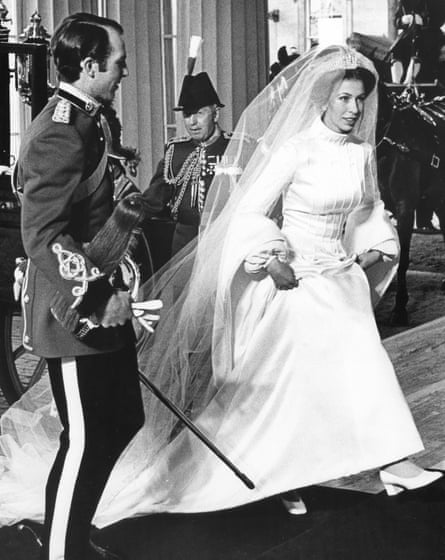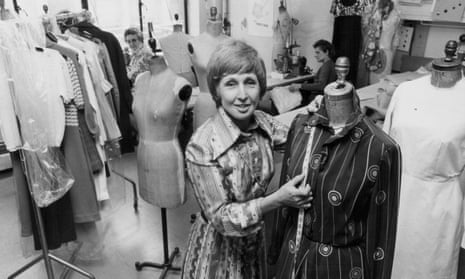Maureen Baker did not go into fashion to make her name, because that was not how the business worked when she started out, picking up pins in the workshop. The names on the labels were those of modest companies with distinctive identities, such as Susan Small, where she designed anonymously for over 30 years. Baker, who has died aged 97, first emerged in public at 53; she had for a while been personally designing for a special Susan Small customer, Princess Anne, who then said: “You will, of course, be making my wedding dress.”
That dress, for the princess’s marriage to Captain Mark Phillips in 1973, was a very big deal. The court designer Norman Hartnell had created Anne’s mother Elizabeth’s wedding gown in 1947, and its relative glamour had been a national obsession amid austerity. Anne had more problems with fashion than her mother and grandmother: attempts by venerable British couturiers to do 1960s styles had made the teenage Anne look like lamb dressed as mutton, while new Brit fashion was too wild for courtly duties. When Anne was 18, Princess Alexandra, a long-term Susan Small customer, had recommended she should put herself in the hands of Baker, its chief designer since 1943.
Maureen was one of six children of a bookmaker, Stephen Porter, and his wife, Ethel, and was educated at a convent school. She found her first job by walking from the family’s home in Hammersmith, west London, into the West End, calling at every clothing business on the way to ask for work. Initial employments were grim, but soon she met Leslie Carr-Jones and his wife, Fay, who had set up Susan Small in the mid-30s as “wholesale couture”, specialising in petite sizes.

They took her on as an apprentice, and she rose quickly to be a designer, but the company’s output was restricted as clothes rationing ran from 1941 to 1949, and most staff had left to do war work. Shortage was a valuable discipline for Baker, who learned about simple but strong line, durability and wearability, and not getting in the way of a good fabric.
After the second world war, the firm became a leading British label: “It’s a Susan Small world,” ran the ads in the glossies. “For a fortunate few”, it sourced quality textiles from newcomers such as Sekers as well as the giant Courtaulds, was respected enough to win UK licensing rights for some Christian Dior lines, was stocked in the best department stores and priced its top-of-the-line daywear, cocktail and hostess dresses in guineas. Leslie Carr-Jones led the London Model House group, which brought together similar companies to export, and modernise British clothing production. Baker headed a design team of three, who went to shows and suppliers worldwide; her job was to synthesise the mood into six Susan Small collections a year. She remained invisible. Any publicity featured Fay Carr-Jones.
From 1968, Baker dressed Anne in everyday life as well as for grand events including the investiture of the Prince of Wales in 1969, in a compromise between the norm for female royals (floral coloured silk, precise fit and finish, blank spaces for the jewellery) and actual fashion. For the wedding dress, Anne suggested a mid-16th-century style - Glenda Jackson had recently swept all before her as Elizabeth I on television, and there was a Tudor vogue.
Utterly thrilled, Baker drank a glass of champagne and then kept up a nervous silence for months, although she was pursued, with enormous bribes, for details of the outfit. In its pearl-bordered restraint, and discreet flattery, the gown looks far less absurd than Princess Diana’s meringue excesses at St Paul’s in 1981. Baker’s trousseau for Anne, with its sharp tailoring, was even better.
The world of Susan Small did not survive the changes in UK clothing manufacture from the mid-70s, when firms requiring limited runs could no longer source domestic suppliers capable of working on time to a high standard. Courtaulds swallowed up the firm.
In 1978, Baker carried Anne, and new clients including Margaret Thatcher, who was regally dogmatic in her demands, over to a tiny couture firm, Maureen Baker Designs, which employed just three seamstresses. They did thoroughly old-fashioned dressmaking – Anne’s maternity clothes, for instance, were altered so she could wear them after pregnancy. All outfits were made to last – some of Anne’s dresses continued to reappear for more than 25 years. Baker retired at 72.
She had met her future husband, Roy Baker, later a dealer in classic cars, at Margate funfair one bank holiday in 1947. They had a son, Jonathan, who became a hotelier. When Roy died in 1990, Baker joined her son in his homes in New York and Jamaica, returning to Dorking, Surrey, each spring to look after her garden. She preferred the ease of her own creations, but in old age settled for shopping at Chanel and Dior.
Jonathan survives her.

Comments (…)
Sign in or create your Guardian account to join the discussion